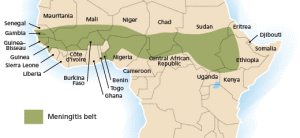Climate Conditions Help Forecast Meningitis Outbreaks
by Michael Shirber, for Astrobiology Magazine
Wind and dust conditions in Sub-Saharan Africa Africa can help predict a meningitis epidemic.
Determining the role of climate in the spread of certain diseases can assist health officials in “forecasting” epidemics. New research on meningitis incidence in sub-Saharan Africa pinpoints wind and dust conditions as predictors of the disease. The results may help in developing vaccination strategies that aim to prevent meningitis outbreaks, such as the 1996-1997 epidemic that killed 25,000 people.
Many diseases become more prominent at certain times of the year. A common example is influenza, which peaks in colder months. Meningitis – an infection of the thin lining surrounding the brain and spinal cord – is also seasonal. In the Sahel (a semi-arid region stretching through Mali, Niger, Chad and Sudan), meningitis incidence is highest in the dry season from November to May.

Estimated dust concentration averaged from October through December over the period 1985-2006 in micrograms of dust per cubic meter.
Credit: Carlos Pérez García-Pando
“For more than 60 years, we have known that meningitis epidemics in sub-Saharan Africa are partly related to climate and environmental conditions,” said Carlos Pérez García-Pando of NASA Goddard Institute for Space Studies and Columbia University. “But factors other than climate, and a lack of data and knowledge have hindered the quantification of this relationship.”
Pérez and his colleagues have compared meningitis incidence in Niger from the years 1986 to 2006 to climate variables over the same time period. In the journal Environmental Health Perspectives, they report that wind strength and surface dust concentration in November and December can be used to predict the rate of meningitis infection over the subsequent months.
“Our paper shows that in Niger dust and wind conditions along with information on the amount of cases during the pre-season months have a certain amount of predictability on the seasonal cases of meningitis,” Pérez said.
Being able to forecast the possibility of a meningitis epidemic could give health officials more time to prepare.
Meningitis Belt
There are several different causes of meningitis, including viruses, bacteria and fungi. However, large outbreaks of the disease are typically the result of the bacteria Neisseria meningitidis. Roughly 10 percent of people carry this bacteria in their throat to no ill effect. The bacteria only become a problem when they infect the meninges, the thin lining around the central nervous system. Bacterial meningitis has a rapid onset that leads to death in roughly 1 in 10 cases. Those that survive often suffer from mental retardation, deafness, epilepsy, or necrosis.

The African meningitis belt. Source: World Health Organization
In the last 100 years, numerous meningitis epidemics have occurred around the world. The most affected area has been the Sahel, or what is sometimes called the “Meningitis Belt.” Every 8 to 12 years, a large epidemic (in which more than 1 out of 1000 people are afflicted) sweeps over this region. The largest recorded epidemic occurred in 1996-1997 with 250,000 cases and 25,000 deaths, according to the World Health Organization (WHO).
Vaccines do exist for bacterial meningitis, but they typically provide immunity for only two to three years. The standard procedure, therefore, has been reactive immunization. If the number of cases in a district reaches a certain threshold, then vaccinations and antibiotics are ordered for that district. But sometimes the response can be too late.
“The problem with the thresholds is that they rely on surveillance, and sometimes there can be delays in reporting,” said William Perea, an epidemiological officer at WHO. Recently, health officials have begun administering a new vaccine that provides long-term immunity. It targets a specific type of Neisseria meningitidis bacteria (designated serogroup A) that accounts for 80 percent of all cases. This vaccine may reduce the threat of epidemics, but other meningitis serogroups are likely to continue to be a problem.
In order to better anticipate future outbreaks, scientists from a variety of disciplines have come together as part of the Meningitis Environmental Risk Information Technologies (MERIT) initiative. Led by WHO in support of health ministries across the Sahel, MERIT aims to create predictive models for the disease based on climate and environmental variables.
“Building a consortium effort has helped speed up the research and its translation to operations,” said Madeleine Thomson, a founder of MERIT from the International Research Institute for Climate and Society.
As part of MERIT, Pérez and Thomson, along with other colleagues, investigated the climate factors that may influence the disease.
Read the rest of this story as it originally appeared in Astrobiology Magazine

You must be logged in to post a comment.